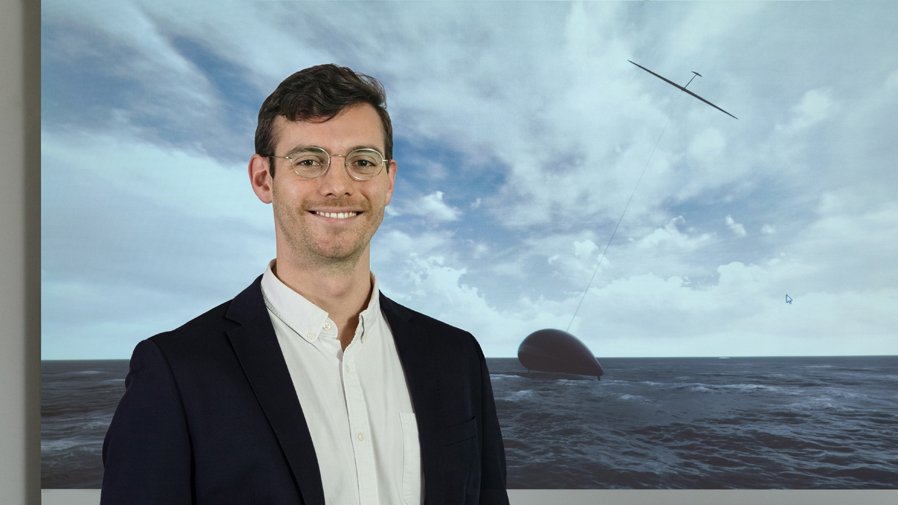TUM Entrepreneurial Masterclass - applications open until February 1
Interview with Entrepreneurial Masterclass student Marcus Bischoff

Cargo Kite is aiming to revolutionize container shipping. What is the plan?
Marcus Bischoff: Over 90% of all global trade currently takes place by sea – and most of the goods are shipped by vessels that run on heavy fuel oil, often without filters. The shipping industry is responsible for 3% of global CO2 emissions. If it were a state, it would be one of the top 6 polluters in the world. On the contrary, wind energy is clean and cost free.
The concept is based on pure wind energy?
Because of the constant strong winds at sea, there has already been a trend towards offshore solutions for quite a while. The problem is that the wind must first be converted, which requires a complex infrastructure. Due to the many conversion processes, the efficiency is relatively low. Therefore, the obvious solution is to use the wind directly, without conversion losses. Cargo Kite achieves this based on an Airborne Wind Energy (AWE) system.
How does this system work?
The main component of our propulsion system is the Kite, [RK1]which flies at an altitude of 100 to 300 meters above the ship's hull, thus pulling the ship. The energy of the high-altitude winds is directly converted into forward motion. Since it is not necessary to have energy storage units, the efficiency is much higher, the system is more environmentally friendly, and less CO2 is emitted.
How can the high-altitude winds be used optimally?
Simply put, the kite flies in the air above the hull, connected to a rope that transfers power to the hull. The Kite [RK2]convert aerodynamic energy into a force vector. High drag forces act on the hull, which is designed to develop a counterforce. This allows to maximize the propulsion system's performance without being limited by the ship's weight. Furthermore, it is possible to achieve steeper angles against the wind and, ultimately, higher speeds.
What about the design of the hull?
Aerodynamic optimization is important – but the key aspect is the possibility to torque-control the hull. When the ship moves, the hull is in a stable position above water, and hydrofoils are used underwater. Cargo Kite's new class of vessels is intended primarily for transportation. The core of the ship can hold four 40-foot standard containers, which is equivalent to a capacity of 100 tons.
Compared to the huge container ships, this is a small capacity. Where is the advantage?
With a fleet of this new class of ships, we are planning on achieving[RK3] the same logistics performance as with large container ships on the world's oceans, but with more flexibility and 100% sustainability. This class of ships is not only much more environmentally friendly, but also cheaper to build due to the elimination of an energy storage system – and, above all, much more flexible. The key is the high-altitude winds. Their probability of occurrence is over 95%, so the ships can operate 350 days a year.
How can such a Cargo Kite be navigated?
We are working on our own route planning algorithm. It calculates the optimal ship route, which is determined by weather conditions, for example. This also makes it easier to predict arrival times, which means greater planning reliability. This is crucial for the cargo ship industry.
A naïve question: Will there still have to be a "captain" on board?
The goal is an autonomously operating fleet. We won't be able to achieve this with the prototype – but the long-term goal is that there will be no crew on board.
You are part of the first Entrepreneurial Masterclass of TUM and UnternehmerTUM. What is your opinion so far?
I think that the Masterclass is a perfect environment. It gives us the greatest freedom to implement our own scientifically relevant ideas. Previously, you had to choose one of the predefined topics for your Master's thesis. Here, we are – at best – able to lay the foundation for our own business start-up, and we are in close exchange with other students from very different scientific disciplines, but with the same entrepreneurial mindset.
What does this exchange look like specifically?
We get together every two weeks for Stand-up Days, where we report on our successes and failures. We do brainstorming, give each other support. The projects are completely different. For example, some are working on a high-efficiency reactor for the process industry, some are developing measures to provide better support for ClimateTech startups, and others are aiming to bring a novel medical device to market. Helmut Schönenberger, CEO of UnternehmerTUM, takes part regularly as well. He contributes valuable ideas and can establish contact with investors.
The turn of the year is approaching. What's next for Cargo Kite in 2021?
At the moment, my team and I are working on the EXIST Transfer of Research application. If everything works out fine, we will be able to push the idea further in this framework next year. This would help us a lot. And of course I assume that we will soon start building the prototype – bringing us a little closer to our vision of sustainably decarbonizing the shipping industry.
(Interview: Verena Meinecke)
Marcus Bischoff, 29, is originally from the Black Forest region. He obtained his Bachelor's degree at Darmstadt Technical University and studied shipbuilding in Rio de Janeiro for one year. He is currently working on his Master's thesis on Cargo Kite at the Institute of Flight System Dynamics at TUM in Garching.
In the „TUM Entrepreneurial Masterclass“, selected entrepreneurial talents are able to focus their Master's thesis on their own research questions – in order to create real added value for their personal startup project, for the startup ecosystem, or for society as a whole. Each year, four "batches" of around 15 members are accepted. Applications for the Masterclass starting on April 1, 2021, have to be submitted by February 1. Application and more information: TUM Entrepreneurial Masterclass